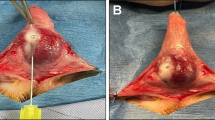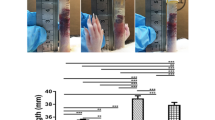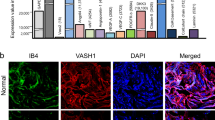Abstract
Penile veno-occlusive dysfunction (venogenic erectile dysfunction) is a common cause of erectile dysfunction (ED). We investigated whether vascular endothelial growth factor (VEGF) can be used to prevent and reverse venogenic ED in a rat model. Pharmacological cavernosometry was developed and validated using adult male rats with either arteriogenic or venogenic ED. Castrated animals were treated with intracavernous VEGF as either a recombinant protein (C+VEGF) or adeno-associated virus (AAV)-mediated VEGF gene therapy (C+VEGF gene) in an attempt to prevent the development of venogenic ED. Other animal groups received testosterone replacement (C+testosterone) or intracavernous AAV-LacZ gene (C+LacZ). Animals with documented venogenic ED were treated with intracavernous VEGF in an attempt to reverse their ED. Functional analysis (pharmacological infusion cavernosometry) was performed following treatment. Penile specimens were harvested for immunohistochemistry and electron microscopic evaluation. Castrated rats showed a decrease in papaverine-induced intracavernous pressure and an increase in maintenance and drop rates during pharmacological cavernosometry. These changes were prevented by systemic testosterone and intracavernous VEGF or AAV-VEGF therapy. Moreover, intracavernous VEGF was able to reverse the venogenic ED produced by castration. The quantity of penile smooth muscle detected by alpha actin staining decreased after castration but not in the C+T, C+VEGF, or C+VEGF gene groups. Transmission electron microscopy revealed atrophy of penile smooth muscle cells and nerves in the castrated rats. In VEGF-treated rats, regeneration of smooth muscle and nerves as well as endothelial cell hypertrophy and hyperplasia were the prominent features. In our animal model, systemic testosterone replacement or intracavernous VEGF (protein and VEGF gene) prevented the veno-occlusive dysfunction in castrated animals. In rats with established venous leakage, VEGF treatment reversed the cavernosometric findings of leakage. Intracavernous injection of either VEGF protein or VEGF gene may be a preferred therapy to preserve erectile function in patients in whom testosterone therapy is contraindicated.
This is a preview of subscription content, access via your institution
Access options
Subscribe to this journal
Receive 8 print issues and online access
$259.00 per year
only $32.38 per issue
Buy this article
- Purchase on Springer Link
- Instant access to full article PDF
Prices may be subject to local taxes which are calculated during checkout



Similar content being viewed by others
References
Lue TF . Contemporary Diagnosis and Management of Male Erectile Dysfunction. Handbooks in Health Care Co.: Newtown, Penn., 1999.
Karadeniz T et al. Judgment of color Doppler ultrasound with respect to cavernous artery occlusion pressure in dynamic infusion cavernosometry when evaluating arteriogenic impotence. Urol Int 1996; 57: 85–88.
Mulhall JP, Graydon RJ . The hemodynamics of erectile dysfunction following nerve-sparing radical retropubic prostatectomy. Int J Impot Res 1996; 8: 91–94.
Mersdorf A et al. Ultrastructural changes in impotent penile tissue: a comparison of 65 patients. J Urol 1991; 145: 749–758.
Rajfer J, Rosciszewski A, Mehringer M . Prevalence of corporeal venous leakage in impotent men. J Urol 1988; 140: 69–71.
Meisel RL, O'Hanlon JK, Sachs BD . Differential maintenance of penile responses and copulatory behavior by gonadal hormones in castrated male rats. Horm Behav 1984; 18: 56–64.
Zvara P et al. Nitric oxide mediated erectile activity is a testosterone dependent event: a rat erection model. Int J Impot Res 1995; 7: 209–219.
Lekås E et al. Decrement of blood flow precedes the involution of the ventral prostate in the rat after castration. Urol Res 1997; 25: 309–314.
Häggström S, Wikström P, Bergh A, Damber JE . Expression of vascular endothelial growth factor and its receptors in the rat ventral prostate and Dunning R3327 PAP adenocarcinoma before and after castration. Prostate 1998; 36: 71–79.
Mills TM, Lewis RW, Stopper VS . Androgenic maintenance of inflow and veno-occlusion during erection in the rat. Biol Reprod 1998; 59: 1413–1418.
Mills TM, Stopper VS, Wiedmeier VT . Effects of castration and androgen replacement on the hemodynamics of penile erection in the rat. Biol Reprod 1994; 51: 234–238.
Franck-Lissbrant I, Häggström S, Damber JE, Bergh A . Testosterone stimulates angiogenesis and vascular regrowth in the ventral prostate in castrated adult rats [see comments]. Endocrinology 1998; 139: 451–456.
Häggström S, Lissbrant IF, Bergh A, Damber JE . Testosterone induces vascular endothelial growth factor synthesis in the ventral prostate in castrated rats. J Urol 1999; 161: 1620–1625.
Liu X et al. Vascular endothelial growth factor promotes proliferation and migration of cavernous smooth muscle cells. J Urol 2001; 166: 354–360.
Jin KL, Mao XO, Greenberg DA . Vascular endothelial growth factor: direct neuroprotective effect in in vitro ischemia. Proc Natl Acad Sci USA 2000; 97: 10242–10247.
Sondell M, Sundler F, Kanje M . Vascular endothelial growth factor is a neurotrophic factor which stimulates axonal outgrowth through the flk-1 receptor. Eur J Neurosci 2000; 12: 4243–4254.
Verdonck A et al. Effect of testosterone replacement after neonatal castration on craniofacial growth in rats. Arch Oral Biol 1998; 43: 551–557.
Parker CR Jr, Ellegood JO, Mahesh VB . Methods for multiple steroid radioimmunoassay. J Steroid Biochem 1975; 6: 1–8.
Su H, Lu R, Kan YW . Adeno-associated viral vector-mediated vascular endothelial growth factor gene transfer induces neovascular formation in ischemic heart. Proc Natl Acad Sci USA 2000; 97: 13801–13806.
Karadeniz T et al. Correlation of ultrastructural alterations in cavernous tissue with the clinical diagnosis vasculogenic impotence. Urol Int 1996; 57: 58–61.
Baumgartner I et al. Constitutive expression of phVEGF165 after intramuscular gene transfer promotes collateral vessel development in patients with critical limb ischemia [see comments]. Circulation 1998; 97: 1114–1123.
Symes JF et al. Gene therapy with vascular endothelial growth factor for inoperable coronary artery disease. Ann Thorac Surg 1999; 68: 830–836; discussion 836–837.
Henry GD et al. Intracavernosal injections of vascular endothelial growth factor protects endothelial dependent corpora cavernosal smooth muscle relaxation in the hypercholesterolemic rabbit: a preliminary study. Int J Impot Res 2000; 12: 334–339.
Byrne RR et al. Vascular endothelial growth factor restores corporeal smooth muscle function in vitro. J Urol 2001; 165: 1310–1315.
Lee MC et al. The effect of vascular endothelial growth factor on a rat model of traumatic arteriogenic erectile dysfunction. J Urol 2002; 167: 761–767.
Mills TM, Dai Y, Stopper VS, Lewis RW . Androgenic maintenance of the erectile response in the rat. Steroids 1999; 64: 605–609.
Hatzichristou DG et al. In vivo Assessment of trabecular smooth muscle tone, its application in pharmaco-cavernosometry and analysis of intracavernous pressure determinants [see comments]. J Urol 1995; 153: 1126–1135.
Karadeniz T et al. Value of color Doppler sonography in the diagnosis of venous impotence. Urol Int 1995; 55: 143–146.
Acknowledgements
This research was supported in part by a grant from the National Institute of Health (NIH-DK51374).
Author information
Authors and Affiliations
Corresponding author
Rights and permissions
About this article
Cite this article
Rogers, R., Graziottin, T., Lin, CS. et al. Intracavernosal vascular endothelial growth factor (VEGF) injection and adeno-associated virus-mediated VEGF gene therapy prevent and reverse venogenic erectile dysfunction in rats. Int J Impot Res 15, 26–37 (2003). https://doi.org/10.1038/sj.ijir.3900943
Received:
Revised:
Accepted:
Published:
Issue Date:
DOI: https://doi.org/10.1038/sj.ijir.3900943
Keywords
This article is cited by
-
Testosterone attenuates senile cavernous fibrosis by regulating TGFβR1 and galectin-1 signaling pathways through miR-22-3p
Molecular and Cellular Biochemistry (2023)
-
MicroRNA-145 engineered bone marrow-derived mesenchymal stem cells alleviated erectile dysfunction in aged rats
Stem Cell Research & Therapy (2019)
-
The Post-finasteride Syndrome: Clinical Manifestation of Drug-Induced Epigenetics Due to Endocrine Disruption
Current Sexual Health Reports (2018)
-
Mesenchymal stem cell-based gene therapy for erectile dysfunction
International Journal of Impotence Research (2016)
-
Intracavernous administration of bone marrow mononuclear cells: a new method of treating erectile dysfunction?
Journal of Translational Medicine (2013)



